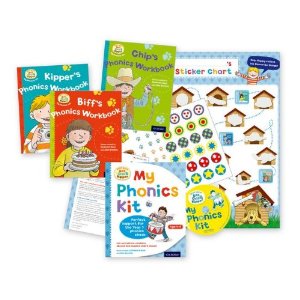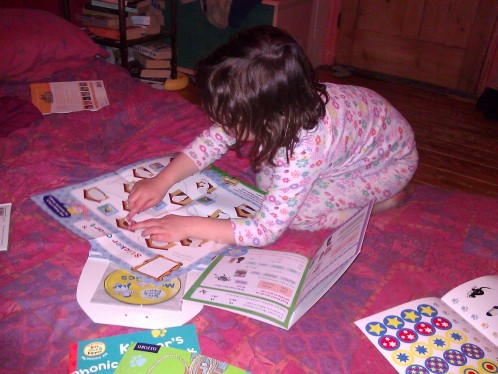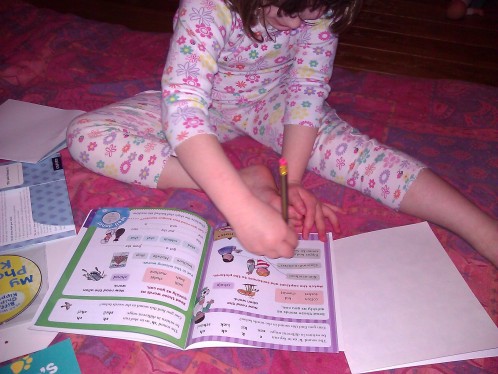My Phonics Kit from Oxford University Press
My Phonics Kit is a pack from Oxford University Press for parents to help their children with phonics and which ties into the new Year 1 Phonics Test (see last week’s Sunday Reading post for my concerns about the test).
 My Phonics Kit contains three workbooks (Kipper’s Phonics Workbook, Chip’s Phonics Workbook and Biff’s Phonics Workbook), instructions and guidance for parents, a reward chart, stickers and a CD-ROM with eBooks and related activities. The pack costs £10, though it’s currently available on Amazon for £6.
My Phonics Kit contains three workbooks (Kipper’s Phonics Workbook, Chip’s Phonics Workbook and Biff’s Phonics Workbook), instructions and guidance for parents, a reward chart, stickers and a CD-ROM with eBooks and related activities. The pack costs £10, though it’s currently available on Amazon for £6.
My Phonics Kit is based on the, almost certainly very familiar, Oxford Reading Tree, that most schools use and so contains familiar characters and artwork. Each workbook has some words for your child to read to see if they’re at the right level for the workbook. (The kit is aimed at children reading at or above Level 5 of the Oxford Reading Tree.) There’s then a page with some tips and guidance for learning together with your child. There are then nine pages, each looking at a specific sound, and the different graphemes that can make that sound. (For example, in Biff’s Phonics Workbook there’s a page on the sound ‘k’ and it covers ‘c’, ‘k’, ‘ck’ and ‘ch’.) There’s a section of words to read and then one or more ‘alien words’ to read (the alien words are indicated by a little picture of an alien and are clearly differentiated from the actual words by being in a different coloured and styled box, as well) that use some of the graphemes introduced on that page. And then there’s an activity for the child to do using the graphemes from that page. For example, there might be an activity to match sentences to pictures, to fill in gaps in sentences, to find sounds within sentences, and so on. Interspersed throughout these pages are whole-page activities, such as larger gap fills, colouring activities (find the words in the picture and then colour the picture) and matching captions to pictures. Each of the workbooks ends with a ‘Silly Ditty’ using lots of words and sounds from that workbook and then a final activity (a wordsearch in one, pairing words together in another and putting words together to make other words in the other workbook).
Throughout the workbooks, children can earn stickers to put in the workbooks and stickers for Floppy to go on the reward chart. The reward chart also has indications of where to read the eBooks on the CD-ROM, though you can actually use the kit in any order you want, including going through the workbooks in whatever order you want. There are six eBooks on the CD-ROM with activities to go with each. There’s also a section for grown-ups, where you can hear the different sounds and find out about the screening test and also read some tips and guidance about helping your children learn to read.
RoRo has tested out My Phonics Kit and really liked it. She enjoyed reading the book on the computer and the way the pages turned. She read the words at the start of the book with no problem (in fact, I was surprised how quickly and easily she read them). She enjoyed doing the activities and wanted to keep going, despite it being late and time to go to bed. She enjoyed finding the stickers and sticking them in the right places. She read the alien words fine, though she definitely struggled more with them than the real words (because, as I mentioned in last week’s post, she doesn’t just decode any more, but uses context and her knowledge of vocabulary to work out a word that she doesn’t already know – neither of which can be used for alien/nonsense words).
I was pleased, as well, that working through some of the pages in the workbook together, had RoRo talking to me about what they’d learnt at school in phonics and spelling – she does talk about school a lot more than she used to, but it’s still always nice to have something that prompts her to talk more about what she’s doing there.
I thought My Phonics Kit was excellent. Oxford University Press have integrated the alien words in an unobtrusive way that should introduce children to the idea of needing to read nonsense words without too much confusion and help them become familiar with the idea. It covers the sounds they should be familiar with at that age and will help them with reading words in isolation in addition to within stories and other texts. I think that My Phonics Kit would be a useful pack to use, regardless of the test, and will be very helpful in providing additional reading-related activities for children to familiarise them with the different graphemes – both for reading and writing. I think there’s a strong chance I would have bought a copy of this and would certainly recommend it to others. The price is very good for what you get – we often buy workbooks from Wilkinsons or the Works which cost a couple of pounds each. They usually have a stickers and definitely more pages than these workbooks, but they don’t come with eBooks and activities on CD-ROM and I don’t think the activities themselves are as targeted as these ones. The familiarity that theOxford Reading Tree brings to the children as well, is an added bonus. I might be tempted to buy it in Reception, rather than Year 1, though, depending on the progress of the individual child. I’m sure LaLa will, at the very least, be reading the eBooks on the computer, as she loves Kipper and Floppy!
Disclaimer: I was sent a copy of My Phonics Kit to review by Oxford University Press, but the opinions expressed are my own (and RoRo’s).



Leave a Reply